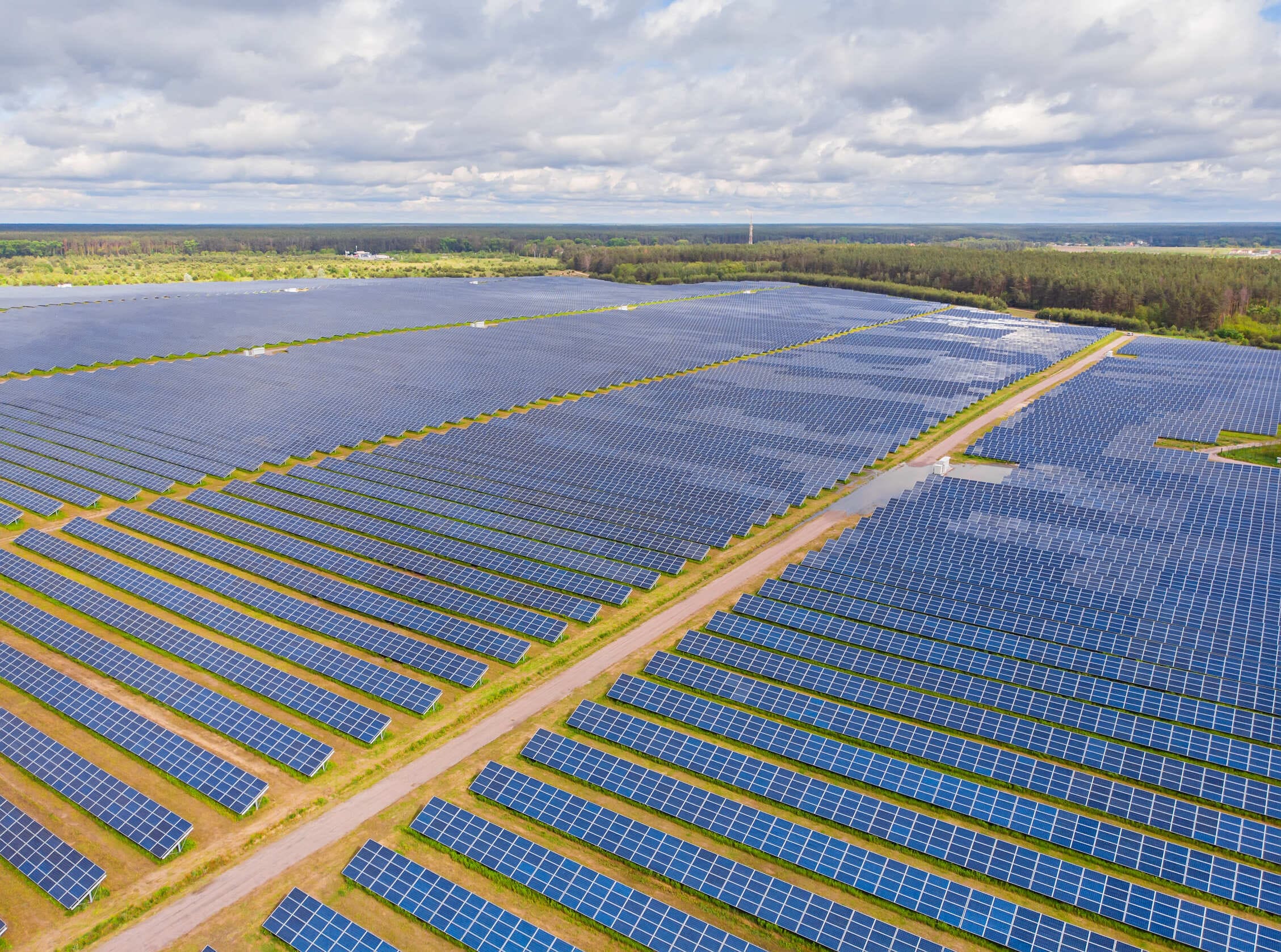

What is utility-scale solar and how does it work? Utility-scale solar installations are large solar power systems that generate over 5 MW of electricity, typically spanning hundreds of acres to supply power directly to utility grids or industrial facilities. These systems differ from residential solar by utilizing advanced photovoltaic panels, single or dual-axis tracking systems that boost output by up to 25%, central inverters, and increasingly, lithium-ion battery storage for peak demand management.
Key benefits include: (1) Cost efficiency with 5-8 year payback periods and up to 30% federal Investment Tax Credit (ITC), (2) Energy independence reducing fossil fuel reliance for manufacturing, data centers, and logistics operations, (3) Environmental impact with 100 MW installations offsetting 100,000+ metric tons of CO₂ annually, and (4) Enhanced grid stability through smart grid integration.
Implementation timeline: Utility-scale solar projects typically require 12-36 months from planning to commissioning, involving site selection, feasibility studies, permitting, engineering, construction, and system activation. Systems are designed for 25-30 year lifespans with proper maintenance extending performance beyond 35 years.
Notable examples: Copper Mountain Solar (Nevada) exceeds 800 MW capacity, while Mount Signal Solar (California) delivers 794 MW. Major corporations like Amazon and Walmart have invested heavily in industrial solar for distribution centers and data infrastructure, achieving break-even in under 6 years in optimal conditions.

What distinguishes utility-scale solar systems is their output capacity and intended application. These installations typically generate more than 5 MW of electricity, connecting directly to power grids or operating under long-term utility agreements. This differentiates them from distributed commercial solar solutions.
Such projects demand extensive land parcels, often spanning hundreds of acres, located in sun-rich areas with minimal obstructions. The electricity produced travels through high-voltage transmission lines to power infrastructure and end users.
Unlike rooftop solar configurations, utility-scale solar farms prioritize bulk energy generation. These installations feature sophisticated tracking mechanisms, grid integration technology, and increasingly, battery storage systems to address peak consumption periods. Their scale drives down per-watt installation expenses, making them an economically sound choice for energy-demanding operations.

Long-Term Financial Savings While utility-scale solar requires substantial upfront capital, the investment delivers significant returns over time. Organizations lock in stable energy pricing, shielding themselves from volatile utility rate increases. Many installations qualify for federal tax incentives, accelerated depreciation programs, and state-level rebates that enhance financial viability.
Power Autonomy and Reliability Widespread solar adoption reduces dependence on fossil fuels and external energy suppliers. For mission-critical sectors like manufacturing, technology, and logistics, this translates to enhanced control, dependable power supply, and uninterrupted operations.
Corporate Sustainability Solar installations dramatically cut carbon dioxide emissions. A standard 100 MW solar facility can eliminate over 100,000 metric tons of CO₂ annually. This advancement supports organizational sustainability targets and strengthens corporate reputation with investors and consumers regarding ESG (Environmental, Social, Governance) performance.
Power Network Strength and Reliability Utility-scale solar incorporating smart grid technology and battery storage bolsters power grid stability. This capability proves essential in regions facing natural disaster risks or struggling with electricity demand growth.
Utility-scale solar relies on cutting-edge technologies to maximize energy generation, system monitoring, and operational efficiency.
Photovoltaic (PV) Modules: These form the foundation of solar farms, converting sunlight into electricity. Utility-scale installations typically deploy high-efficiency monocrystalline panels.
Solar Tracking Mechanisms: Single- or dual-axis tracking systems enable panels to follow the sun's trajectory, boosting output by up to 25% compared to fixed-angle installations.
Power Inverters: These devices convert DC electricity from panels into AC power suitable for grid distribution. Large-capacity central inverters are standard for utility-scale applications. Understanding the electrical fundamentals behind these systems is crucial for optimal performance.
Battery Storage Solutions: Lithium-ion storage systems are increasingly integrated to capture surplus energy for use during low-production periods or peak demand times.
Advanced Monitoring Systems: Real-time analytics and remote management capabilities optimize performance and reduce operational interruptions. Proper documentation, including solar three-line diagrams, ensures clarity in system design.

Developing a utility-scale solar installation requires multiple coordinated phases:
Site Evaluation: Locating land with strong solar resources, limited shading, and accessible grid connections.
Feasibility Assessment: Conducting solar irradiation analysis, terrain evaluation, environmental review, and financial projections.
Regulatory Approval: Managing zoning requirements, governmental regulations, and stakeholder engagement. The permitting process can significantly impact project timelines, and understanding community planning considerations is essential for successful development.
Engineering & Material Acquisition: Developing system design, procuring equipment, and contracting construction teams. Proper wire management and conduit practices ensure long-term system reliability.
Project Construction: Executing site preparation, panel mounting, electrical infrastructure, and grid connection. Structural engineering requirements must account for panel tilt and load design.
System Activation: Conducting comprehensive testing before transferring to operations and maintenance (O&M) personnel.
American enterprises can access diverse commercial solar pathways:
Funding Structures: Options include PPAs (power purchase agreements), leases, and solar financing programs.
Tailored Systems: Specialized designs for corporate facilities, agricultural operations, manufacturing plants, and distribution centers through professional solar design services.
Public Incentives: The Federal Investment Tax Credit (ITC), MACRS depreciation benefits, and state rebate programs reduce financial barriers.
These mechanisms enable organizations of varying sizes to adopt solar with limited initial expenditure.

Assessing ROI for utility-scale solar involves weighing initial capital investment (CapEx) against continuous savings and incentive benefits:
CapEx vs. OpEx Approaches: PPAs and leases convert upfront expenses into operational costs, improving cash flow management.
Standard Recovery Timeline: Investment recovery typically occurs within five to eight years, influenced by project scale, geographic location, and available incentives. For comparison, understanding home solar system costs follows similar financial principles on a smaller scale.
Illustration: A 50 MW installation at a Texas distribution facility achieved break-even in under 6 years due to strong solar exposure and favorable tax benefits.
Utility-scale solar adapts to diverse industry requirements:
Heavy Industry: Counterbalances significant electricity consumption in sectors like automotive, aluminum, and steel manufacturing.
Technology Infrastructure: Data center operators utilize solar for reliable uptime and environmental credentials.
Retail & Business Complexes: Expansive rooftops and parking structures provide excellent platforms for integrated solar arrays.
These systems frequently incorporate backup battery capacity and AI-powered demand management.
Solar energy developments carry substantial social and environmental significance:
Ecological Stewardship: Project developers collaborate with environmental authorities to address land-use impacts, often following ordinance considerations for grid-scale solar.
Employment Generation: Solar farm construction and upkeep create thousands of American jobs each year.
Local Partnership: Numerous projects establish community benefit funds or provide discounted electricity to neighboring residents.
Copper Mountain Solar (Nevada): Among America's largest installations with over 800 MW output, delivering power to hundreds of thousands of households.
Mount Signal Solar (California): A 794 MW facility developed in stages, providing renewable electricity to Southern California.
Enterprise Initiatives: Companies like Amazon and Walmart have made substantial investments in industrial solar for logistics facilities and data infrastructure.
These examples demonstrate concrete advantages in operational savings, emissions reductions, and expansion potential. Stay informed about the latest developments through resources like EnergySage and Renewable Energy World.
Selecting appropriate partners proves critical:
EPC Firms: Prioritize proven track records, financial stability, and comprehensive project portfolios.
Equipment Suppliers: Assess warranty terms, efficiency specifications, and technical support quality. Pay attention to DC connector quality to prevent fires and system failures.
Essential Inquiries: Request details about system reliability guarantees, O&M strategies, and expansion capabilities.
Partner credibility directly influences project success.
Large-scale American solar projects operate within an intricate regulatory structure:
Federal Authority: Installations often require FERC and NEPA compliance.
State Requirements: Regulations differ considerably; certain states provide expedited permitting while others mandate extensive environmental assessments. Understanding permitting and interconnection timelines helps manage expectations.
Grid Connection Agreements: Must be negotiated with regional utilities, typically involving technical evaluations and interconnection queue positions. Both supply-side connections and load-side interconnection options have distinct requirements. Familiarity with solar codes and standards is essential.

Property Acquisition: Demands navigation of zoning codes and community concerns.
Supply Network Instability: Component scarcities and pricing volatility can postpone timelines.
Environmental Hazards: Engineering must accommodate floods, high winds, and wildfires, particularly in susceptible regions.
Risk reduction approaches, including dual-purpose land strategies and supplier diversification, are essential. For alternative solutions, off-grid solar system design offers independence from grid vulnerabilities.
Water-Based Solar Arrays: Minimizes land competition and improves efficiency through water-cooling effects.
AI-Powered Grid Management: Optimizes demand forecasting, load distribution, and maintenance prediction.
Combined Energy Systems: Integrating solar with wind power, storage capacity, or hydrogen production for continuous renewable energy.
The trajectory of industrial solar points toward intelligent, scalable, and interconnected systems. Follow industry trends on The Energy Mix for the latest innovations.
Organizations seeking to reduce expenses, secure stable energy access, and meet sustainability objectives should prioritize utility-scale solar installations. The enduring benefits, spanning financial savings to environmental impact reduction, far outweigh the initial complexity and investment requirements.
Success in planning and implementing solar farm projects for industrial facilities or exploring commercial solar solutions for corporate properties depends on partnering with experienced vendors and understanding the complete development process. Solar Permit Solutions offers expert guidance to streamline your utility-scale solar project. Get in touch with our team or explore our blog for additional insights.
What defines a utility-scale solar installation?
Generally, any solar power system exceeding 5 MW intended for grid connection or industrial application qualifies as utility-scale or large-scale.
What's the construction timeline for a solar farm?
From initial planning through system activation, the timeline ranges from 12–36 months based on regulatory processes, project size, and environmental conditions.
How long do utility-scale solar systems last?
Most installations are engineered for 25–30 year lifespans, with appropriate maintenance enabling performance beyond 35 years.
Are off-grid solar farms feasible?
Though most utility-scale installations connect to power grids, off-grid operation is achievable with adequate storage infrastructure and backup systems.
How do tax incentives apply to major solar projects?
Qualifying installations can receive up to 30% of total project expenses through the federal Investment Tax Credit (ITC), alongside accelerated depreciation (MACRS) benefits and possible state incentives.
We are dedicated to providing top-notch solar permit services to homeowners, business owners, DIY, and solar installers. Contact us today.